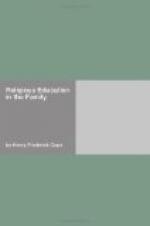A large section of real family life is missing in families that do not sing together. A home without song lacks one of the strongest bonds of family unity, and the after-years will be deprived of a memory dear indeed to many others. Days often come when the wheels of family life seem to develop friction, when little rifts seem to throw the members far apart, but the evening song brings them together. The unity of action, of feeling, the development of emotions above the day’s irritation and strife, all help to new joys in family living.
We may well think of the fine songs and the great hymns together. There is no fixed wall between “Mine Eyes Have Seen the Glory,” and “The Son of God Goes Forth,” nor between “My Old Kentucky Home” and “Jerusalem the Golden.” The modern home has the musical instruments to lead in song—though they are not always essential—and lacks only the planning and forethought to develop the joys of song. It must provide the thought that applies the simpler forms of musical expression to the sweetening and enriching of life.
Let no one say, “My family is not musical.” That simply means that your family does not take time for music and song. Build on the training in patriotic and folk-songs given in the schools; sing these same songs over in the home and then associate with the best of them the best of the hymns. Cultivate the habit of binding the whole realm of feeling in music together, the hymns and the songs, to make religion mean beauty and devotion and to make the finer sentiments of life truly religious.
This costs time and thought. Someone must plan that the books of songs and hymns are provided, that the opportunity is given, and that wise, unobtrusive leadership is there. Have ready several copies of the book containing the best hymns. Think out your plan of procedure in advance, selecting the songs, or at least the first one. Then at the right time simply begin to play that song and you will scarcely need to invite the children to sing with you.
Should anyone doubt whether children will enjoy singing good hymns, he may purchase a few records for the phonograph, for example, “O Come All Ye Faithful,” “Hark the Herald Angels Sing,” “O Zion Haste,” “Holy, Holy, Holy,” “Abide with Me.” These will suit those of from ten upward; younger children will enjoy “Can a Little Child Like Me,” “Brightly Gleams Our Banner,” “Jesus Loves Me.” “I Think When I Read That Sweet Story,” and “For the Beauty of the Earth,” though they will join gladly in the other hymns. Or, instead of using the phonograph, sit down quietly at the piano and play these hymns, with just enough emphasis for the children to catch the rhythm, and they will soon be standing at the piano singing with you.[16]




